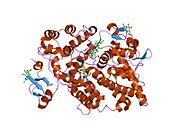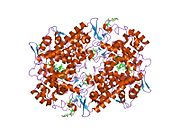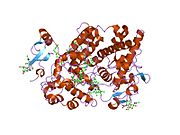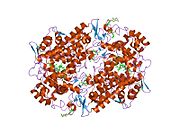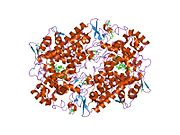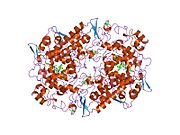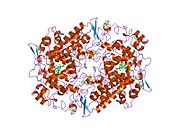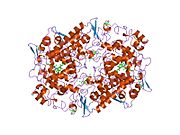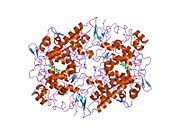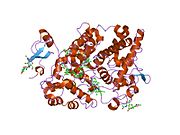Cyclooxygenase-1
| PTGS1 | |||
|---|---|---|---|
Gene ontology | |||
| Molecular function | |||
| Cellular component | |||
| Biological process |
| ||
| Sources:Amigo / QuickGO | |||
Ensembl | |||||||||
|---|---|---|---|---|---|---|---|---|---|
| UniProt | |||||||||
| RefSeq (mRNA) |
| ||||||||
| RefSeq (protein) |
| ||||||||
| Location (UCSC) | Chr 9: 122.37 – 122.4 Mb | Chr 2: 36.12 – 36.14 Mb | |||||||
| PubMed search | [3] | [4] | |||||||
| View/Edit Human | View/Edit Mouse |
Cyclooxygenase 1 (COX-1), also known as prostaglandin-endoperoxide synthase 1 (HUGO PTGS1), is an enzyme that in humans is encoded by the PTGS1 gene.[5][6] In humans it is one of two cyclooxygenases.
History
Cyclooxygenase (COX) is the central enzyme in the biosynthetic pathway to prostaglandins from
Gene and isozymes
There are two
Function
While metabolizing arachidonic acid primarily to PGG2, COX-1 also converts this fatty acid to small amounts of a racemic mixture of
COX-1 promotes the production of the natural mucus lining that protects the inner stomach and contributes to reduced acid secretion and reduced pepsin content.[18][19] COX-1 is normally present in a variety of areas of the body, including not only the stomach but any site of inflammation.
Clinical significance
COX-1 is inhibited by nonsteroidal anti-inflammatory drugs (NSAIDs) such as aspirin. Thromboxane A2, the major product of COX-1 in platelets, induces platelet aggregation.[20][21] The inhibition of COX-1 is sufficient to explain why low dose aspirin is effective at reducing cardiac events.
See also
- Arachidonic acid
- Cyclooxygenase
- Cyclooxygenase 2
- NSAID
- Discovery and development of COX-2 selective inhibitors
- COX-2 selective inhibitor
References
- ^ a b c GRCh38: Ensembl release 89: ENSG00000095303 – Ensembl, May 2017
- ^ a b c GRCm38: Ensembl release 89: ENSMUSG00000047250 – Ensembl, May 2017
- ^ "Human PubMed Reference:". National Center for Biotechnology Information, U.S. National Library of Medicine.
- ^ "Mouse PubMed Reference:". National Center for Biotechnology Information, U.S. National Library of Medicine.
- PMID 2512924.
- S2CID 46147389.
- PMID 12973429.
- S2CID 9407329.
- ^ "Entrez Gene: PTGS1 prostaglandin-endoperoxide synthase 1 (prostaglandin G/H synthase and cyclooxygenase)".
- PMID 12242329.
- PMID 19752399.
- PMID 16005201.
- PMID 4723909.
- PMID 4215079.
- PMID 9785378.
- PMID 21068195.
- S2CID 9158244.
- PMID 18549814.
- ISBN 978-0-07-146633-2.
- ISBN 0-07-142280-3.
- ISBN 978-0-07-146633-2.
Further reading
- Richards JA, Petrel TA, Brueggemeier RW (February 2002). "Signaling pathways regulating aromatase and cyclooxygenases in normal and malignant breast cells". The Journal of Steroid Biochemistry and Molecular Biology. 80 (2): 203–12. S2CID 12728545.
- Wu T, Wu H, Wang J, Wang J (2011). "Expression and cellular localization of cyclooxygenases and prostaglandin E synthases in the hemorrhagic brain". Journal of Neuroinflammation. 8: 22. PMID 21385433.
- Jain S, Khuri FR, Shin DM (2004). "Prevention of head and neck cancer: current status and future prospects". Current Problems in Cancer. 28 (5): 265–86. PMID 15375804.
- Bingham S, Beswick PJ, Blum DE, Gray NM, Chessell IP (October 2006). "The role of the cylooxygenase pathway in nociception and pain". Seminars in Cell & Developmental Biology. 17 (5): 544–54. PMID 17071117.
- Diaz A, Reginato AM, Jimenez SA (May 1992). "Alternative splicing of human prostaglandin G/H synthase mRNA and evidence of differential regulation of the resulting transcripts by transforming growth factor beta 1, interleukin 1 beta, and tumor necrosis factor alpha". The Journal of Biological Chemistry. 267 (15): 10816–22. PMID 1587858.
- Takahashi Y, Ueda N, Yoshimoto T, Yamamoto S, Yokoyama C, Miyata A, Tanabe T, Fuse I, Hattori A, Shibata A (January 1992). "Immunoaffinity purification and cDNA cloning of human platelet prostaglandin endoperoxide synthase (cyclooxygenase)". Biochemical and Biophysical Research Communications. 182 (2): 433–8. PMID 1734857.
- Vane JR, Mitchell JA, Appleton I, Tomlinson A, Bishop-Bailey D, Croxtall J, Willoughby DA (March 1994). "Inducible isoforms of cyclooxygenase and nitric-oxide synthase in inflammation". Proceedings of the National Academy of Sciences of the United States of America. 91 (6): 2046–50. PMID 7510883.
- Mollace V, Colasanti M, Rodino P, Lauro GM, Nistico G (August 1994). "HIV coating gp 120 glycoprotein-dependent prostaglandin E2 release by human cultured astrocytoma cells is regulated by nitric oxide formation". Biochemical and Biophysical Research Communications. 203 (1): 87–92. PMID 7521167.
- Inoue H, Yokoyama C, Hara S, Tone Y, Tanabe T (October 1995). "Transcriptional regulation of human prostaglandin-endoperoxide synthase-2 gene by lipopolysaccharide and phorbol ester in vascular endothelial cells. Involvement of both nuclear factor for interleukin-6 expression site and cAMP response element". The Journal of Biological Chemistry. 270 (42): 24965–71. PMID 7559624.
- Ren Y, Loose-Mitchell DS, Kulmacz RJ (February 1995). "Prostaglandin H synthase-1: evaluation of C-terminus function". Archives of Biochemistry and Biophysics. 316 (2): 751–7. PMID 7864630.
- Picot D, Loll PJ, Garavito RM (January 1994). "The X-ray crystal structure of the membrane protein prostaglandin H2 synthase-1". Nature. 367 (6460): 243–9. S2CID 4340064.
- Kosaka T, Miyata A, Ihara H, Hara S, Sugimoto T, Takeda O, Takahashi E, Tanabe T (May 1994). "Characterization of the human gene (PTGS2) encoding prostaglandin-endoperoxide synthase 2". European Journal of Biochemistry. 221 (3): 889–97. PMID 8181472.
- Otto JC, DeWitt DL, Smith WL (August 1993). "N-glycosylation of prostaglandin endoperoxide synthases-1 and -2 and their orientations in the endoplasmic reticulum". The Journal of Biological Chemistry. 268 (24): 18234–42. PMID 8349699.
- O'Neill GP, Ford-Hutchinson AW (September 1993). "Expression of mRNA for cyclooxygenase-1 and cyclooxygenase-2 in human tissues". FEBS Letters. 330 (2): 156–60. S2CID 26397839.
- Corasaniti MT, Melino G, Navarra M, Garaci E, Finazzi-Agrò A, Nisticò G (September 1995). "Death of cultured human neuroblastoma cells induced by HIV-1 gp120 is prevented by NMDA receptor antagonists and inhibitors of nitric oxide and cyclooxygenase". Neurodegeneration. 4 (3): 315–21. PMID 8581564.
- Ballif BA, Mincek NV, Barratt JT, Wilson ML, Simmons DL (May 1996). "Interaction of cyclooxygenases with an apoptosis- and autoimmunity-associated protein". Proceedings of the National Academy of Sciences of the United States of America. 93 (11): 5544–9. PMID 8643612.
- Hla T (January 1996). "Molecular characterization of the 5.2 KB isoform of the human cyclooxygenase-1 transcript". Prostaglandins. 51 (1): 81–5. PMID 8900446.
- Mahida YR, Beltinger J, Makh S, Göke M, Gray T, Podolsky DK, Hawkey CJ (December 1997). "Adult human colonic subepithelial myofibroblasts express extracellular matrix proteins and cyclooxygenase-1 and -2". The American Journal of Physiology. 273 (6 Pt 1): G1341-8. PMID 9435560.
- Tsujii M, Kawano S, Tsuji S, Sawaoka H, Hori M, DuBois RN (May 1998). "Cyclooxygenase regulates angiogenesis induced by colon cancer cells". Cell. 93 (5): 705–16. S2CID 12704830.



